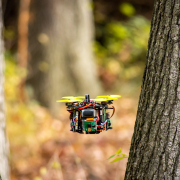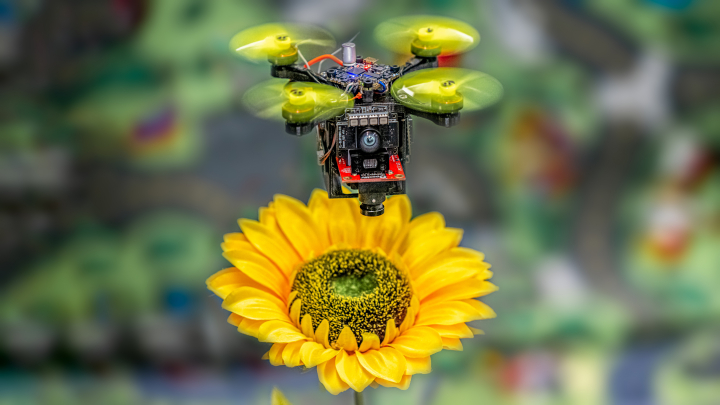UMD Alum Chahat Deep Singh Creates Tiny Drones Inspired by Small Animals
In the natural world, where every graceful flutter of a hummingbird's wings or nimble scuttle of an insect highlights a sophisticated survival and perception system, a similar, albeit artificial, marvel is unfolding in the realm of technology. Alum Chahat Deep Singh (Ph.D. ’23, computer science), a postdoctoral associate at the Maryland Robotics Center, is leading pioneering research to significantly advance the capabilities of palm-sized robots by equipping them with autonomous functionalities reminiscent of nature's most adept small creatures.
Singh's work focuses on "minimal perception," a framework aimed at emulating the high-efficiency perception systems found in small animals, like insects and hummingbirds. These creatures navigate and survive using minimal resources, a principle Singh integrates with artificial intelligence to innovate in robotics.
"Our philosophy centers on the idea that less is more," Singh said. "Traditional robots are equipped with large depth sensors, some as long as three to four inches, which is quite bulky compared to the robots we're working with. We've shifted to using a tiny sensor paired with a standard, inexpensive RGB camera costing less than a dollar. This setup cuts costs and size and, when integrated through our AI framework, produces high-resolution depth maps allowing effective navigation in various environments."
Natural Inspiration
Singh’s fascination with robotics started long before his work at the University of Maryland. Initially captivated by the mechanics of animal locomotion, Singh's early interests laid the foundation for his future research endeavors.
"Even before coming to UMD, I was intrigued by how the walking algorithms of animals and birds are encoded in our genes," Singh explained. “This curiosity about natural movement and adaptation propelled me to explore more complex systems.”
In 2016, Singh met Department of Computer Science Professor Yiannis Aloimonos. This meeting enriched Singh’s understanding of computer vision and perception, which examines how humans and animals interpret their surroundings.
"From Professor Yiannis, I learned how perception operates in living beings, which led me to explore the minimalism theory in linguistics proposed by Noam Chomsky," Singh said. "It suggests that in language and perception, beings evolve to operate with the minimum necessary for effective communication and survival."
 These insights inspired Singh to apply these principles to robotic technology, particularly drones, which, unlike self-driving cars, are not limited by terrain.
These insights inspired Singh to apply these principles to robotic technology, particularly drones, which, unlike self-driving cars, are not limited by terrain.
Observing research trends in 2017 and 2018 that relied heavily on large sensors and high computational power, Singh saw an opportunity for innovation in making hardware smaller, less expensive and less power-intensive.
"While researching at UMD, I questioned the minimal requirements needed to accomplish a task under the constraints of limited computing, sensing and power," Singh said. "This exploration set the stage for my current research path, guiding me toward developing more efficient, autonomous systems that incorporate minimalism into robotics for substantial functionality with reduced resource dependency."
Overcoming Small Challenges
Robotics encompasses various scales and scopes, but Singh’s focus is uniquely challenging: developing robots smaller than six inches that can perform critical tasks autonomously in confined spaces. These tasks range from space inspections in tight quarters to potential assistance in agriculture through robotic pollination.
Researchers traditionally equip terrestrial or aerial robots with high-powered computing systems and sensors to enable autonomous decisions. This approach has generally been applied to larger, more expensive, potentially dangerous robots.
Singh believes there is room for improvement.
"Standard research drones measure about 250 millimeters, but my research focuses on developing drones around 100 millimeters or less," Singh shared. "Not only are these smaller drones 10 times cheaper, but their lighter weight and smaller size also reduce the risk of injury, typically causing minor scratches, making them safer for crowded spaces, which can be revolutionary in many sectors and circumstances."
Moving Forward
As the possibilities for small robots continue to expand, the work of researchers like Singh promises to reshape industries and redefine technological boundaries.
"Our work on minimal perception has the potential to revolutionize how small robots are used in various industries," Singh expressed. "In aerospace, these robots could navigate and inspect complex, confined spacecraft structures. In agriculture, they could aid in pollination processes, which is crucial in regions facing bee population declines."
Singh's research may soon explore new frontiers, suggesting that small innovations can lead to significant technological advancements.
"The future of these minimal robots is about more than just creating smaller, more efficient machines," Singh shared. "It's about redefining autonomy, focusing on systems that can operate independently in environments where traditional robots might fail, or human intervention is impractical, leading to new frontiers in robotics."
—Story by Samuel Malede Zewdu, CS Communications
The Department welcomes comments, suggestions and corrections. Send email to editor [-at-] cs [dot] umd [dot] edu.
